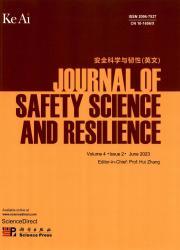Novel explicit models for assessing the frictional resistance of pipe piles subjected to seismic effects
IF 3.4
Q1 PUBLIC, ENVIRONMENTAL & OCCUPATIONAL HEALTH
引用次数: 0
Abstract
This paper introduces novel explicit models to predict the frictional resistance of open and closed-ended pipe piles subjected to seismic loading. This research employs genetic programming (GP) and multiobjective genetic algorithm-based evolutionary polynomial regression (EPR-MOGA) to develop closed-form expressions for estimating pile frictional resistance, utilizing widely used input parameters for enhanced practicality and applicability in engineering practice. The proposed models are developed using only three input variables: the corrected standard penetration test (SPT) blow count (N1)60, the pile slenderness ratio (L/D), and the peak ground acceleration (PGA). This deliberate reduction in input complexity significantly enhances the models' applicability across a wide range of geotechnical scenarios and industries. The accuracy of the developed models was assessed via the coefficient of determination (R2), root mean squared error (RMSE), and mean absolute error (MAE). In the case of the GP model, the evaluation metrics for the testing set for open-ended piles (R2, RMSE, and MAE values) are 0.89, 0.43, and 0.35, respectively, whereas the corresponding values for closed-ended piles are 0.93, 0.38, and 0.3, respectively. On the other hand, the EPR-MOGA approach achieves similarly encouraging results, with performance metrics of 0.92, 0.37, and 0.29 for open-ended piles and 0.91, 0.39, and 0.30 for closed-ended piles.
评估地震作用下管桩摩阻力的新显式模型
本文引入了新的显式模型来预测地震荷载作用下开端和闭端管桩的摩阻力。本研究采用遗传规划(GP)和基于多目标遗传算法的进化多项式回归(EPR-MOGA),利用广泛使用的输入参数,建立了估算桩侧摩阻力的封闭表达式,以增强工程实践中的实用性和应用性。所提出的模型仅使用三个输入变量:修正的标准贯入试验(SPT)吹风计数(N1)60,桩长细比(L/D)和峰值地面加速度(PGA)。这种刻意降低输入复杂性的做法显著提高了模型在岩土工程场景和行业中的适用性。通过决定系数(R2)、均方根误差(RMSE)和平均绝对误差(MAE)来评估所建立模型的准确性。在GP模型中,开放式桩测试集的评价指标(R2、RMSE和MAE值)分别为0.89、0.43和0.35,封闭式桩测试集的评价指标分别为0.93、0.38和0.3。另一方面,EPR-MOGA方法取得了同样令人鼓舞的结果,开放式桩的性能指标为0.92、0.37和0.29,封闭式桩的性能指标为0.91、0.39和0.30。
本文章由计算机程序翻译,如有差异,请以英文原文为准。
求助全文
约1分钟内获得全文
求助全文
来源期刊

安全科学与韧性(英文)
Management Science and Operations Research, Safety, Risk, Reliability and Quality, Safety Research
CiteScore
8.70
自引率
0.00%
发文量
0
审稿时长
72 days
 求助内容:
求助内容: 应助结果提醒方式:
应助结果提醒方式:


